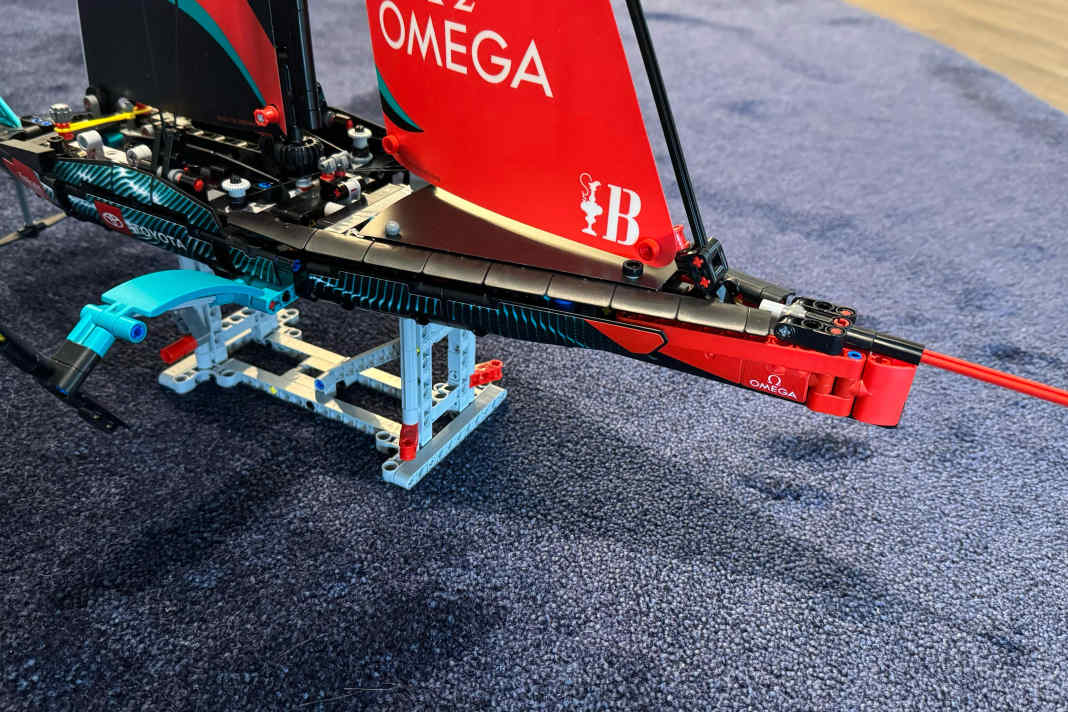





When the Danish brick giant Lego launched a miniature of a current America's Cup yacht on the market in August, the response from fans of the legendary sailing competition was huge. Never before had there been such a Technic model as the AC75 from Emirates Team New Zealand.
The set with the number 42174 aims to impress with a multitude of real-life technical details. These include the mast, which can be rotated as on the racing yacht, the mainsail made of two individual skins that can be trimmed using the traveller and the adjustable self-tacking jib. However, one special feature of the current Cup yachts stands out in particular: the foils. Lego spared no expense or effort in equipping the heart of the racers, which can reach speeds of over 100 kilometres per hour, with pneumatics. This means that the foil arms can be moved up and down individually, as happens during manoeuvres in front of Barcelona.
37th America's Cup: Lego also integrates cyclists
Anyone following the 37th America's Cup will know that such pressure-based systems are actually on board the Cuppers. In contrast to the previous edition off Auckland, however, no classic grinders are used. Instead, four cyclists provide the required energy with some almost unbelievable performance values. Although the model's frame has to be cranked by hand, the pedals are actually indicated in the sidepod cockpits and move. This is probably the most realistic-looking detail of the Lego Technic model, but in no way represents reality.
In fact, the sails are only trimmed using the energy generated on board. "The cyclists drive pumps below deck and control the setting of the sails," explains Scott Barnesm, senior hydraulics engineer for the Emirates Team New Zealand defenders. The foils and their arms, each weighing around half a tonne, are now fully battery-operated. The foil arm and its hydraulics are a one-design component that allows the teams to tack or jibe approximately every 15 seconds. This is how long the system needs to build up sufficient pressure.
The flight controller on board also relies on battery-powered hydraulics. The flaps on the rudder and on the main foils must work accordingly in order to sail at the optimum attitude and height in all conceivable situations. This makes hydraulics a crucial component for success on the regatta course. Whether the detailed realisation of these functions would also have been decisive for the Lego model is something every fan must decide for themselves, but it would have been desirable.
Just like in reality: America's Cupper is not cheap
Meanwhile, there is little to complain about the assembly process. The detailed and well thought-out building instructions allow even master builders under the suggested age recommendation of 18 to construct the high-tech glider without spoiling the building fun for experienced Lego enthusiasts. Instead, the set offers good variety and increases in complexity. Only the optional application of the numerous sponsor stickers and the installation of the pneumatic hoses is somewhat tedious. The end product after around three to four hours of building time is a visually appealing model that reflects the dimensions and the Design of the New Zealand AC75 impressively.
The 22.86 metre long and five metre wide "Taihoro" measures 56 by 12 centimetres in the Lego Technic replica (33 cm with the foil arms folded out on both sides). The mast of the 962-piece set is 68 centimetres high, while the rig of the original rises 26.5 metres into the air. Originally offered for 120 euros, the model is available at Amazon currently available for 87.99 euros. Regardless of the outcome of the America's Cup match against Ben Ainslie's Louis Vuitton Cup winner from Ineos Britannia, which starts on Saturday, the model is therefore ideal as a display piece for any Cup and Lego enthusiast. The AC75 replica made of bricks should also cut a fine figure as a Christmas present under the Christmas tree, for example.
Will "Luna Rossa" soon be available in Lego?
It is one of the few boat models in the range of the world's top-selling toy manufacturer in 2023. Inventors, on the other hand, continue to create racing yachts, even from the classic square building blocks. This included the then 16-year-old Tobias Sprung, who constructed a 1:45 scale model of the "Seaexplorer" after Boris Herrmann's first Vendée Globe participation in 1964. He submitted this to Lego Ideas, where the Luna Rossa", already eliminated from the 37th America's Cup is to be found.
Ideas is a platform where Lego fans can submit their own designs for new sets. Other users then have the opportunity to support these suggestions. If a design reaches 10,000 supporters within a set period of time, it will be scrutinised by a Lego review team. This team will then decide whether the proposed set will go into production and be officially released by LEGO. Around 8,500 votes are still missing before Luna Rossa Prada Pirelli's AC75 could also go into production. However, it should be noted that Lego may have to acquire the rights to certain brands or names, which could complicate the process.
Winny Hohensee and Karl Kühmstedt also designed and built their extravagant Lego model completely independently of this. The X-362 from 9,114 individual parts was on show at the last boot Düsseldorf.

